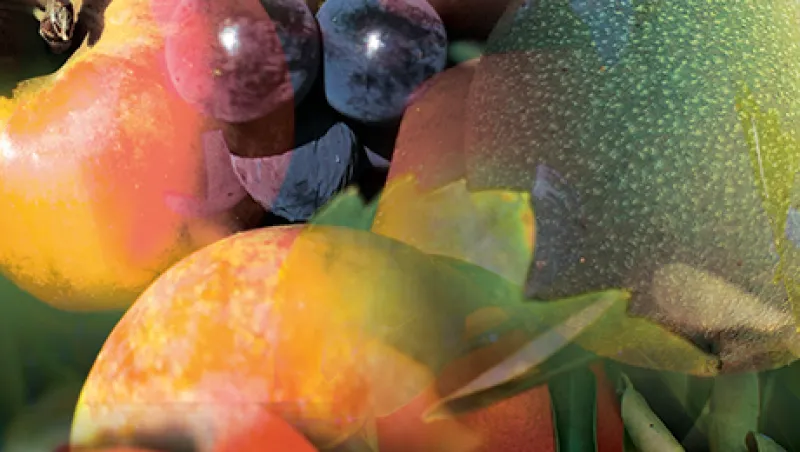Row crops such as wheat and corn have long been a staple of farmland portfolios. But some investors hope to harvest greater rewards by diversifying into the so-called permanent crops: fruits and nuts that grow on trees and vines.
This farmland comes with higher risks. It takes years for a tree or vine to become productive, and consumer tastes can change in the meantime. That’s what happened with Red Delicious apples, notes James McCandless, head of global real estate, farmland, at UBS AgriVest, a division of UBS Global Asset Management. “About 100,000 acres of Red Delicious turned into firewood” because people decided they liked Galas better, says McCandless, whose Hartford, Connecticut–based firm had almost $1 billion invested in farmland as of March.
But the potential returns are higher too. The nut group — almonds, pecans, pistachios and walnuts — is particularly strong thanks to health-conscious consumers and exports to a growing middle class in emerging markets. In California there’s a boom in the conversion of farmland from “low-value annual crops” like wheat, corn and barley to permanent ones, especially nuts and wine grapes, says Karen Klonsky, an outreach specialist in the Department of Agricultural and Resource Economics at the University of California, Davis.
The NCREIF Farmland Index, from the Chicago-based National Council of Real Estate Investment Fiduciaries, has posted a ten-year annualized return of 17.57 percent, including income and land appreciation. But for income, permanent crops rule. At the recent Global AgInvesting conference in New York, Rory Robertson, CEO for horticultural crops with Westchester Group Investment Management, used the NCREIF index to show that these crops’ annualized income has climbed from 13.06 percent to 18.28 percent in the past decade. Income from annual cropland has hovered at about 4 percent.
TIAA-CREF, which bought a controlling stake in Champaign, Illinois–based Westchester in 2010 for its farmland management skills, has a long-term strategy to split crop investments 70-30 between row and permanent, says agriculture portfolio manager Justin (Biff) Ourso. The $569 billion, New York–based investment firm had about $4.5 billion in farmland assets at the end of 2013. TIAA-CREF’s permanent crops include wine grapes, almonds, walnuts, pistachios, citrus, apples, avocados and cranberries, Ourso says.
With row crops TIAA-CREF buys the land and leases it back to farmers who assume the risk, but it manages permanent crops itself via Westchester. The investment in the trees or vines is considerable — “anywhere from 50 percent to 80 percent of the value of the farm,” Ourso explains.
UBS AgriVest would like to put about 20 percent of its total capital into permanent crops. So far, the firm has allocated just 11 percent because “it’s been difficult to find attractively priced permanent crop properties,” farmland head McCandless says. But it recently invested $14 million and $7.6 million in California vineyards and apple orchards, respectively, and $13.25 million in Florida citrus groves. UBS AgriVest leases all of its land back to farmers. The lease structure differs for permanent crops, though: The firm gets a percentage of gross income, McCandless says.
Benjamin King, founder and managing principal of Arbor Nutrio, a Chicago nut-farming start-up, cited some impressive statistics at the Global AgInvesting conference. Between 2007 and 2012 gross revenue per acre for almonds surged 48.5 percent, to $5,573; for walnuts it rose 79 percent, to $6,167. Pistachios and pecans showed healthy gains too: 22.7 percent and 19.2 percent, respectively.
King, who grew up on a farm in Colusa, California, left MCP Asset Management Co., a Hong Kong–based hedge fund he co-founded, to launch Arbor Nutrio last November. Already the owner of almond and pecan orchards in California worth about $25 million, he plans to buy California walnut and pistachio properties, and pecan farms elsewhere in the U.S., with an emphasis on shelling and marketing the nuts. So far, King has put up his own money, but he’d like to raise $100 million starting in the fourth quarter, via a commingled fund or with two or three investors.
Jamie Shen, a senior vice president at San Francisco–based Callan Associates, an investment consulting firm that advises on nearly $2 trillion in assets, says institutional demand for farmland is so strong that she knows of three asset managers with a combined $1.4 billion sitting on the sidelines. It will be a struggle to invest that money, Shen predicts. “A lot of farmers are flush with cash and are looking to expand,” she says. “The biggest competition is the farmer next door.” • •
Get more on alternatives.






